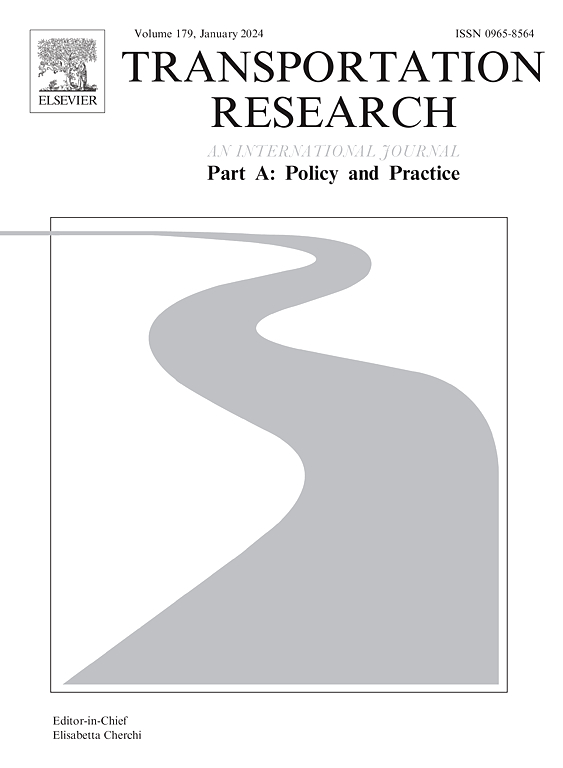基于旅行调查和手机网络数据的长途模式选择估算
IF 6.3
1区 工程技术
Q1 ECONOMICS
Transportation Research Part A-Policy and Practice
Pub Date : 2024-10-30
DOI:10.1016/j.tra.2024.104293
引用次数: 0
摘要
交通需求模型预测的准确性在本质上受到基础数据质量的限制。传统上,交通调查是估算交通需求模型的主要数据来源,但随着交通调查响应率的下降,这一问题也凸显出来。与此同时,不需要被调查者积极参与的手机网络数据也越来越多。然而,手机网络数据中并没有收集到一些能增强估算模型预测能力的关键行程和旅客特征。因此,我们在本文中研究了将移动电话网络数据与旅行调查数据相结合,利用每种数据源的优势来估算长途模式选择模型的益处。我们联合手机网络数据和旅行调查数据,提出并估算了一套模式选择需求模型。我们的研究结果表明,将两种数据源结合在一起所得出的估算结果比单独使用每种数据源估算出的模型更可信。除出发地、目的地、出行方式、出行目的、被调查者的年龄和性别外,出行调查最好还包括以下变量:出行人数、每户牌照汽车数、牌照持有数。本文章由计算机程序翻译,如有差异,请以英文原文为准。
Long-distance mode choice estimation on joint travel survey and mobile phone network data
The accuracy of a transport demand model’s predictions is inherently limited by the quality of the underlying data. This issue has been highlighted by the decline in response rates for transport surveys, which have traditionally served as the primary data source for estimating transport demand models. At the same time, mobile phone network data, not requiring active participation from subjects, have become increasingly available. However, some key trip and traveller characteristics enhancing the prediction power of the estimated models are not collected in mobile phone network data. In this paper we therefore investigate what can be gained from combining mobile phone network data with travel survey data, using the strengths of each data source, to estimate long-distance mode choice models. We propose and estimate a set of mode choice demand models on joint mobile phone network data and travel survey data. We show that combining the two data sources produces more credible estimates than models estimated on each data source separately. The travel survey should preferably include the variables: travel party size, cars per household licence, licence holding, in addition to origin, destination, mode, trip purpose, age, and gender of the respondent.
求助全文
通过发布文献求助,成功后即可免费获取论文全文。
去求助
来源期刊
CiteScore
13.20
自引率
7.80%
发文量
257
审稿时长
9.8 months
期刊介绍:
Transportation Research: Part A contains papers of general interest in all passenger and freight transportation modes: policy analysis, formulation and evaluation; planning; interaction with the political, socioeconomic and physical environment; design, management and evaluation of transportation systems. Topics are approached from any discipline or perspective: economics, engineering, sociology, psychology, etc. Case studies, survey and expository papers are included, as are articles which contribute to unification of the field, or to an understanding of the comparative aspects of different systems. Papers which assess the scope for technological innovation within a social or political framework are also published. The journal is international, and places equal emphasis on the problems of industrialized and non-industrialized regions.
Part A''s aims and scope are complementary to Transportation Research Part B: Methodological, Part C: Emerging Technologies and Part D: Transport and Environment. Part E: Logistics and Transportation Review. Part F: Traffic Psychology and Behaviour. The complete set forms the most cohesive and comprehensive reference of current research in transportation science.

 求助内容:
求助内容: 应助结果提醒方式:
应助结果提醒方式:


